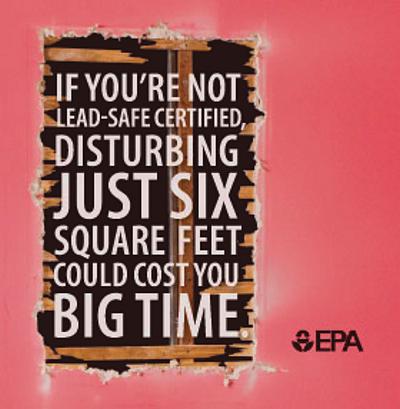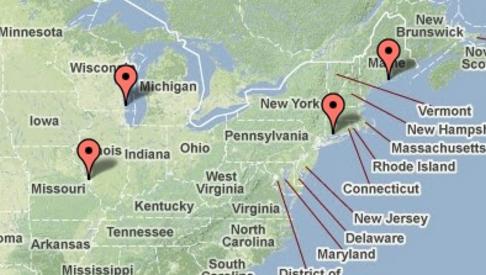EPA Publishes First RRP Enforcement of Lead Safe Work Practices
Today the EPA announced it's first enforcement actions against a renovator for violations of the lead-safe work practices required under the RRP Rule.
 The press release below explains how the violator was investigated after a YouTube video of the the renovator's workers in action was posted showing the total lack of lead-safe work practices in place as the workers used power equipment to remove paint on a rental property on Rockland ME.
The press release below explains how the violator was investigated after a YouTube video of the the renovator's workers in action was posted showing the total lack of lead-safe work practices in place as the workers used power equipment to remove paint on a rental property on Rockland ME.
EPA’s investigation found that Mr. Wentworth failed to: obtain required certification as a renovation firm from EPA; post warning signs in the work area; cover the ground in the work area with plastic sheeting to collect falling lead paint debris; contain waste from the renovation activities to prevent releases of dust and debris before the waste is removed from the work area for storage or disposal; prohibit use of machines that remove lead-based paint through high speed operation without HEPA exhaust controls; and establish and maintain records necessary to demonstrate compliance with the Renovation Rule.
Click here to watch the video which provided all the evidence the EPA needed.
 Will this be the first of many press releases by EPA regarding enforcement? Many contractors who have complied with the RRP rule hope so. According to Curt Spalding, regional administrator of EPA’s New England office: "Enforcement of these rules is important to protecting children and the business interests of those contractors who are following the rules.”
Will this be the first of many press releases by EPA regarding enforcement? Many contractors who have complied with the RRP rule hope so. According to Curt Spalding, regional administrator of EPA’s New England office: "Enforcement of these rules is important to protecting children and the business interests of those contractors who are following the rules.”
Time will tell if anyone else at EPA other Curt Spalding recognizes the importance of enforcement.

News Release
U.S. Environmental Protection Agency
New England Regional Office
May 16, 2011
Contact: David Deegan, (617) 918-1017
Maine Renovator Faces Penalty for Violations of Lead Renovation Rule
(Boston, Mass. – May 16, 2011) – A Rockland, Maine renovator is facing penalties for allegedly violating requirements designed to protect children from exposure to lead-based paint during painting and other renovation activities.
According to information gathered by inspectors from the Maine Department of Environmental Protection, the U.S. Department of Labor’s Occupational Safety and Health Administration and EPA, two workers employed by Colin Wentworth of Rockland failed to contain dust and debris generated by lead paint removal activities during a repainting project in October 2010. Although Mr. Wentworth had completed the eight-hour course required by the Lead Renovation, Repair and Painting (RRP) Rule, he did not provide the required training or supervision to his employees to ensure that they followed the required work practices prior to their use of high-speed dust-generating power tools to remove lead paint from the building. Mr. Wentworth also failed to take steps to obtain the mandatory lead-safe certification for his firm.
The violations were brought to EPA’s attention via an anonymous tip linking to a video of the violations, posted on YouTube and taken in October 2010. The video documented workers using power equipment to remove lead paint from an exterior wall of a residential building without using any containment for lead-containing dust and debris.
At least six children, one of whom was under six years old, lived in the four-unit building at the time of the project. Infants and young children are especially vulnerable to lead paint exposure, which can cause developmental impairment, reading and learning disabilities, impaired hearing, reduced attention span, hyperactivity and behavioral problems. Adults with high lead levels can suffer difficulties during pregnancy, high blood pressure, nerve disorders, memory problems and muscle and joint pain.
EPA’s investigation found that Mr. Wentworth failed to: obtain required certification as a renovation firm from EPA; post warning signs in the work area; cover the ground in the work area with plastic sheeting to collect falling lead paint debris; contain waste from the renovation activities to prevent releases of dust and debris before the waste is removed from the work area for storage or disposal; prohibit use of machines that remove lead-based paint through high speed operation without HEPA exhaust controls; and establish and maintain records necessary to demonstrate compliance with the Renovation Rule.
“In New England we have a high proportion of older houses where lead paint can still be present. It is critically important that all tradespeople understand and follow the RRP requirements so that during renovations, children are not exposed to lead and face serious, life-long health consequences,” said Curt Spalding, regional administrator of EPA’s New England office. “Many renovation firms have done the right thing by becoming certified, sending their employees to training and following the appropriate, health-protective work practices. Enforcement of these rules is important to protecting children and the business interests of those contractors who are following the rules.”
EPA’s Renovation, Repair and Painting Rule is designed to prevent exposure to lead-based paint and/or lead-based paint hazards. The rule requires individuals performing renovations for compensation at most pre-1978 housing to be properly trained. There are certification and training requirements for individual renovators and firms performing renovations to ensure that safe work practices are followed during renovations.
This is the first action EPA has brought against a company or individual for lead safe work-practice violations, under the Renovation, Repair and Painting Rule which became effective on April 22, 2010. The maximum penalty for the alleged violations is $37,500 per violation per day.
This case highlights the importance of high-quality tips that include the name, address, and phone number of the person who allegedly violated the rule, and contain details about the violations observed. While every such tip doesn’t always result in a formal enforcement action, EPA follows through on tips to identify if violations have occurred and if public or environmental health has been jeopardized.
- Report environmental violation tips anywhere in the USA (http://www.epa.gov/compliance/complaints/index.html)
- Report lead hazard tips in New England: (http://www.epa.gov/region1/enforcement/leadpaint/RenovationRepairPaintComplaintForm.html)
More information:
- Lead paint RRP rule (http://epa.gov/lead/pubs/renovation.htm)
- Why lead is a health hazard (http://epa.gov/lead/pubs/leadinfo.htm#health)
# # #
If you are looking for forms and signage to help you with comply with the EPA RRP rule, I recommend you check out what The Lead Paint Forms Store has to offer. They offer a complete assortment of multi-part carbon forms, signage and checklists to assist you and your employees with RRP compliance
 Keep in mind that the rule requires that renovators keep all required documentation and that it be available for EPA audit for 3 years. That means EPA can retroactively enforce the rule 3 years back. If and when enforcement happens, all EPA needs to do is ask to see a renovators documentation to determine whether all the regulated work performed during that 3 year period was properly documented, met the rule’s requirements and that property owners and/or tenants received the required Renovate Right pamphlet, any lead testing results documentation as well as a copy of the required renovation checklist. Remember, the fine is up to $37,500 per violation per day!
Keep in mind that the rule requires that renovators keep all required documentation and that it be available for EPA audit for 3 years. That means EPA can retroactively enforce the rule 3 years back. If and when enforcement happens, all EPA needs to do is ask to see a renovators documentation to determine whether all the regulated work performed during that 3 year period was properly documented, met the rule’s requirements and that property owners and/or tenants received the required Renovate Right pamphlet, any lead testing results documentation as well as a copy of the required renovation checklist. Remember, the fine is up to $37,500 per violation per day! Plus, one fact that many business owners may not be aware of is that, under the rule, the business owner can be held civilly liable for violating the rule. Don’t assume you are personally protected just because of the legal status of your business.
Plus, one fact that many business owners may not be aware of is that, under the rule, the business owner can be held civilly liable for violating the rule. Don’t assume you are personally protected just because of the legal status of your business.
 Looking for accurate information about the EPA RRP rule?
Looking for accurate information about the EPA RRP rule?  At a RRP workshop I attended last week, sponsored by the Lead and Environmental Hazards Association (LEHA), several renovators complained to Mike Wilson of EPA about EPA’s handling so far of the RRP rule. One after the other renovators cited examples of projects they had lost to other businesses that are ignoring the rule. Several even reported home owners had laughed at them when they tried discussing the rule and its requirements. One attendee reported that a homeowner actually told him that he would find another contractor who would ignore the rule as a way of saving money. It all seemed to be new news to Mike Wilson who told us he oversees RRP Policy, so could not comment specifically about enforcement. When asked what message he would bring back to the EPA in Washington after the meeting, Mike said he would let them know that regulated contractors wanted a level playing field. Attendees let Mike know that they have been already giving that same message to EPA, perhaps if Mike delivers the message the leadership at EPA will listen and take action.
At a RRP workshop I attended last week, sponsored by the Lead and Environmental Hazards Association (LEHA), several renovators complained to Mike Wilson of EPA about EPA’s handling so far of the RRP rule. One after the other renovators cited examples of projects they had lost to other businesses that are ignoring the rule. Several even reported home owners had laughed at them when they tried discussing the rule and its requirements. One attendee reported that a homeowner actually told him that he would find another contractor who would ignore the rule as a way of saving money. It all seemed to be new news to Mike Wilson who told us he oversees RRP Policy, so could not comment specifically about enforcement. When asked what message he would bring back to the EPA in Washington after the meeting, Mike said he would let them know that regulated contractors wanted a level playing field. Attendees let Mike know that they have been already giving that same message to EPA, perhaps if Mike delivers the message the leadership at EPA will listen and take action. The press release below explains how the violator was investigated after a YouTube video of the the renovator's workers in action was posted showing the total lack of lead-safe work practices in place as the workers used power equipment to remove paint on a rental property on Rockland ME.
The press release below explains how the violator was investigated after a YouTube video of the the renovator's workers in action was posted showing the total lack of lead-safe work practices in place as the workers used power equipment to remove paint on a rental property on Rockland ME.  Will this be the first of many press releases by EPA regarding enforcement? Many contractors who have complied with the RRP rule hope so. According to Curt Spalding, regional administrator of EPA’s New England office: "Enforcement of these rules is important to protecting children and the business interests of those contractors who are following the rules.”
Will this be the first of many press releases by EPA regarding enforcement? Many contractors who have complied with the RRP rule hope so. According to Curt Spalding, regional administrator of EPA’s New England office: "Enforcement of these rules is important to protecting children and the business interests of those contractors who are following the rules.” 
 On the other hand, since taking over the RRP Rule in MA, working with MA state officials has been much more productive. The Massachusetts Department of Labor Standards (DLS), formally called the Massachusetts Division of Occupational Safety, under the leadership of the department's Director Heather Rowe, has been very receptive to meeting with concerned stakeholders, hearing and recognizing stakeholder's concerns, and working with stakeholders to address their concerns. Currently, in addition to working on amendments to the RRP regulations in MA to address concerns, the DLS is also finalizing their plans to step up enforcement and compliance actions this spring as the home improvement season begins. Is it happening as fast as we all might like, no. However, based on budget and resource realities, I think DLS is doing a good job listening and prioritizing their efforts.
On the other hand, since taking over the RRP Rule in MA, working with MA state officials has been much more productive. The Massachusetts Department of Labor Standards (DLS), formally called the Massachusetts Division of Occupational Safety, under the leadership of the department's Director Heather Rowe, has been very receptive to meeting with concerned stakeholders, hearing and recognizing stakeholder's concerns, and working with stakeholders to address their concerns. Currently, in addition to working on amendments to the RRP regulations in MA to address concerns, the DLS is also finalizing their plans to step up enforcement and compliance actions this spring as the home improvement season begins. Is it happening as fast as we all might like, no. However, based on budget and resource realities, I think DLS is doing a good job listening and prioritizing their efforts. As one way to continue their efforts and interact with stakeholders, the Massachusetts Department of Labor Standards is looking for additional input from contractors and lead industry practitioners in anticipation of making amendments to the MA RRP regulations. An official from this agency will be participating in a May 18 workshop on the RRP Rule being held in Marlborough, MA sponsored by the Lead and Environmental Hazards Association (LEHA) and will be discussing the Department’s plans for revising the RRP regulations as well as the Department's enforcement efforts.
As one way to continue their efforts and interact with stakeholders, the Massachusetts Department of Labor Standards is looking for additional input from contractors and lead industry practitioners in anticipation of making amendments to the MA RRP regulations. An official from this agency will be participating in a May 18 workshop on the RRP Rule being held in Marlborough, MA sponsored by the Lead and Environmental Hazards Association (LEHA) and will be discussing the Department’s plans for revising the RRP regulations as well as the Department's enforcement efforts.
 In my opinion this tool will be helpful for those renovators following RRP requirements for a variety of reasons. For example, it will help level the playing field for legally operating businesses if the awareness of audits persuades illegal businesses to change their ways. Because the tool allows those reporting audits to include details about the audit, renovators will learn what to expect and how to better handle an audit if one happens to them. Also, for those who like to help their peers, being able to submit a report that is informative and shares constructive advice becomes a win-win for both the reporter and those who read the reports.
In my opinion this tool will be helpful for those renovators following RRP requirements for a variety of reasons. For example, it will help level the playing field for legally operating businesses if the awareness of audits persuades illegal businesses to change their ways. Because the tool allows those reporting audits to include details about the audit, renovators will learn what to expect and how to better handle an audit if one happens to them. Also, for those who like to help their peers, being able to submit a report that is informative and shares constructive advice becomes a win-win for both the reporter and those who read the reports. On the other hand, the tool will not likely be helpful to those who knowingly and willfully violate the rule. Knowing where EPA, OSHA and/or states agencies are doing inspections or audits won’t be much help in hiding from an inspector. As we have seen, job site inspections are not likely. Removing magnetic signs or parking their trucks out of view won’t protect violators from an audit. The required documentation gives the authorities the ability to retroactively inspect work practices as well as compliance with owner and occupant pre-notification requirements. Because the EPA rule dictates that all required documentation be kept for three years, one visit to a renovator’s office by EPA can uncover enough violations and justify enough fines to put an illegal business out of business. The Massachusetts requirement for storing documents is 10 years, giving illegal businesses in that state much more to be worried about.
On the other hand, the tool will not likely be helpful to those who knowingly and willfully violate the rule. Knowing where EPA, OSHA and/or states agencies are doing inspections or audits won’t be much help in hiding from an inspector. As we have seen, job site inspections are not likely. Removing magnetic signs or parking their trucks out of view won’t protect violators from an audit. The required documentation gives the authorities the ability to retroactively inspect work practices as well as compliance with owner and occupant pre-notification requirements. Because the EPA rule dictates that all required documentation be kept for three years, one visit to a renovator’s office by EPA can uncover enough violations and justify enough fines to put an illegal business out of business. The Massachusetts requirement for storing documents is 10 years, giving illegal businesses in that state much more to be worried about.


 The definition of ‘readily available’ varies widely. For example, OSHA allows up to 24 hours for businesses to produce some types of required records. When the EPA inspector walks in and asks for your RRP documents, you should be able to open a file drawer, pull out a box, or hand them a CD with all of your records within a 15 to 30 minute time frame. Otherwise, they pull out their ticket book and start writing violations.
The definition of ‘readily available’ varies widely. For example, OSHA allows up to 24 hours for businesses to produce some types of required records. When the EPA inspector walks in and asks for your RRP documents, you should be able to open a file drawer, pull out a box, or hand them a CD with all of your records within a 15 to 30 minute time frame. Otherwise, they pull out their ticket book and start writing violations. EPA does not allow hearsay compliance. If it isn’t written down, it didn’t happen. You can stand there and tell them that you used containment on every job. But, a picture of your jobsites with you pointing to the warning sign outside your containment demonstrates compliance beyond any doubt. Pictures are worth a thousand words…and don’t forget to set your date and time stamp on your photo.
EPA does not allow hearsay compliance. If it isn’t written down, it didn’t happen. You can stand there and tell them that you used containment on every job. But, a picture of your jobsites with you pointing to the warning sign outside your containment demonstrates compliance beyond any doubt. Pictures are worth a thousand words…and don’t forget to set your date and time stamp on your photo.
 According to an
According to an  The following is News Release from EPA, published on February 8, 2011. Though not specific to the RRP Rule, this action by both EPA and the FBI shows that willfull violators of lead related regulations are currently a major focus for EPA and they are serious about prosecuting violators.
The following is News Release from EPA, published on February 8, 2011. Though not specific to the RRP Rule, this action by both EPA and the FBI shows that willfull violators of lead related regulations are currently a major focus for EPA and they are serious about prosecuting violators.  Although their primary purpose is to represent and protect their members, the efforts of these trade associations also benefit remodelers and therefore should be recognized. I thought this would be a good opportunity to recognize some of these associations. The list below is by no means complete as I am sure there are many other associations contributing as well. If I have missed any that you know of please name them by posting a comment below. I will add them to the list in the body of this article as I am made aware of them.
Although their primary purpose is to represent and protect their members, the efforts of these trade associations also benefit remodelers and therefore should be recognized. I thought this would be a good opportunity to recognize some of these associations. The list below is by no means complete as I am sure there are many other associations contributing as well. If I have missed any that you know of please name them by posting a comment below. I will add them to the list in the body of this article as I am made aware of them. Two recent efforts by trade associations recently came across my attention. One was by the National Association of the Remodeling Industry (NARI). In a
Two recent efforts by trade associations recently came across my attention. One was by the National Association of the Remodeling Industry (NARI). In a  I suggest that the two letters contain some very good points and are well written. Renovators with similar concerns could, using the content of these two letters as a reference, write to their own local politicians and or to EPA to express their concerns and demand that EPA recognize the challenges small businesses are having as a result of the rule as well as EPA’s lack of adequate administration and enforcement of the rule.
I suggest that the two letters contain some very good points and are well written. Renovators with similar concerns could, using the content of these two letters as a reference, write to their own local politicians and or to EPA to express their concerns and demand that EPA recognize the challenges small businesses are having as a result of the rule as well as EPA’s lack of adequate administration and enforcement of the rule.




